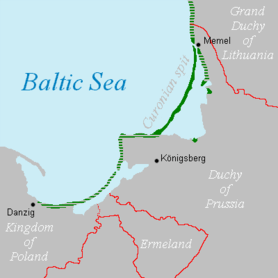Kursenieki language
Kursenieki language (Kursenieki: kursisk valuod; Latvian: kursenieku valoda) or Curonian language of Curonian isthmus[2] (German: Nehrungskurisch – 'Spit Curonian') is a dialect of the Latvian language spoken by the Kursenieki of the Curonian Spit, a thin strip of land stretching between southwestern Lithuania and Russia. In the process of various migrations of the 14th–17th centuries, Curonians (already speaking a Latvian dialect) settled along the Curonian Spit in East Prussia and became known as Kursenieki.
| Kursenieki language | |
|---|---|
| kursisk valuod | |
| Region | Curonian Spit (historically), Germany (nowadays) |
Native speakers | 2 full, 3 partial, a few passive speakers[1] |
| Language codes | |
| ISO 639-3 | – |
| Glottolog | None |
Kursenieki language was influenced by Old Prussian, Low German, High German and the Samogitian dialect successively, and by the end of the 18th century new Curonian dialects had formed, with the dialect of the Curonian Spit being notably distinct, due to its isolation from the mainland. Kursenieki vocabulary published in 1927 shows: 60% of Curonian words were the same as Latvian, 26% were loanwords from “German” (i.e. Low German and High German), and 13% from Lithuanian dialects. The Kursenieki language is mutually intelligible with Latvian, especially its southwestern dialects.[3]
History

Before World War II, the Kursenieki language was a sociolect of Curonian fishermen of the Curonian Spit. In other spheres of everyday life, Kursenieki used the Low German and High German languages. The events of the first half of the 20th century, including the Soviet and German occupations of the Baltic states and later East Prussia, led to the near extinction of the language, making it severely endangered. Several remaining native speakers live in Germany, having been expelled as "Germans" in the ethnic cleansing that took place in East Prussia after World War II.
Several pages of sample texts in Kursenieki language are included in the 1888 monograph Über die Sprache der preussischen Letten by Adalbert Bezzenberger and the 1927 monograph Kursenieku valoda by Juris Plāķis, where they describe the language spoken by the inhabitants of the Curonian Spit.[4]
There is a 2002 documentary film Tarp aštuonių vėjų ("Amidst Eight Winds") by Arvydas Barysas about the endangered Kursenieki language. The film, introducing the Curonian Spit, speaks about three brothers Sakutis (plural: Sakučiai) who had moved from the Spit to Sweden about 60 years ago, but still speak "kuršiškai".[5][6] In 2005 the film won the Best Overall Production Award at the second European Heritage Film Festival in Toblach (Italy) under the patronage of Europa Nostra.[7]
See also
References
- Dalia Kiseliunaite: The sociolinguistic evaluation and recording of the dying Kursenieku language. Klaipėda University
- Skujiņa, Valentīna (2007). Valodniecības pamatterminu skaidrojošā vārdnīca. Riga: Latvian Language Agency. ISBN 978-99-849-8369-1.
- Pietsch, Richard: Deutsch-Kurisches Wörterbuch, Verlag Nordostdeutsches Kulturwerk Lüneburg 1991, p.17, ISBN 3-922296-60-2
- Bojtár, Endre (1999). Foreword to the Past: A Cultural History of the Baltic People. Central European University Press. p. 217. ISBN 963-9116-42-4.
- "ACTIVITY REPORT 2004, LITHUANIAN NATIONAL COMMISSION FOR UNESCO "
- "Tarp 8 vėjų" the DVD annotation at an author's webpage (retrieved June 23, 2019)
- EUROPA NOSTRA Pan-European Federation for Heritage - NEWSLETTER Spring 2005